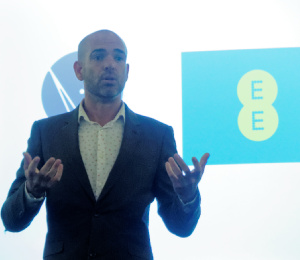V-Nova held a press conference to update on the firm’s progress since TV Connect and then NAB.
 Matt Stagg of EE endorsed V-NovaAn executive from major UK telco, EE, Matt Stagg started by saying that a telephone company and a video codec company do not usually talk together. However, EE believes that 75% of 4G will be video by 2019 and LTE broadcast is interesting for the future. That will need a lot of bandwidth and there are parts of the UK where the signal is not so good.
Matt Stagg of EE endorsed V-NovaAn executive from major UK telco, EE, Matt Stagg started by saying that a telephone company and a video codec company do not usually talk together. However, EE believes that 75% of 4G will be video by 2019 and LTE broadcast is interesting for the future. That will need a lot of bandwidth and there are parts of the UK where the signal is not so good.
Stagg showed a video of how he went to “the New Forest” in the UK – well away from any transmitters and Perseus (supported in software) was able to deliver FullHD at 1.5Mbps with 1280 x 720 at 300Kbps in extremely marginal mobile broadband conditions. The codec is also said to support UltraHD at 50fps using just 6 Mbits and with good quality.
(Elsewhere at the show we mentioned this to a very long established HEVC developer who said “anyone can do that” and proceeded to tweak his demo, but at that low level, the breakup of his own HEVC demo was very obvious! – Man. Ed.)
Eric Achtmann, the company chairman, said that in five months, since NAB there has been a big change at V-Nova from being a novelty to a serious technology.
Guido Meardi, the CEO of V-Nova, said that there were a lot of questions after the launch and he said at that time that there would be “commercial traction” and that has happened. The company has added fifteen new partnerships since NAB and the company’s team has grown by 50%. IRT, the research institute, has said that the quality of Perseus is good enough for contribution (see notes below).
Achtman said that the company has been working with Airbus as we have reported. As SES pointed out, aerospace uses a lot of video and bandwidth.
Meardi said that vendors have reacted in record time to the technology and he announced Imagine Communication and Thomson Video Networks (said to be one of the top three compression vendors globally) as partners and Perseus is being added to the Thomson supported codecs.
How could this happen in just five months, Meardi asked? First, with the codec, you can use the equipment you already have. It also uses the existing workflows and uses current standards for packaging, transport, metadata and DRM. It also is interoperable with existing codecs.
Meardi also said that in contribution, you could create “visually lossless UltraHD” at 300Mbit/sec which can be streamed over unmanaged standard TCP/IP networks allowing very cost effective remote production (Uncompressed, Sky Deutschland was talking of over 8GBits/second for UltraHD P50 with HDR at IFA)
In distribution, Meardi claimed that UHD can be distributed over HD networks and infrastructure. CloudPVRs become practical and you can expand IPTV and OTT reach (by 10X, Meardi said). Perseus is “ready for prime time”. At NAB there were four partners, but by IBC there are 12 partners on display at the show (and big names).
Interview with Guido Meardi
We met with Meardi and discussed the company’s development. He said that the firm is nervous about revealing too much about its codecs, except under NDAs to partners, and that is causing some nervousness in the press and with prospective partners. On the other hand, the company has made a lot of very important deals with big and conservative companies. He also said that one of the challenges for the company is that a lot of potential partners have tests for codecs that have been very optimised to highlight particular issues in MPEG codecs. If you just run those short and specialised tests, you don’t see the full benefit of the Perseus technology, so often V-Nova has to get testers to look at longer tests where the “hierarchical” nature of the codec starts to really pay off.
One point that Meardi made that we hadn’t heard before, is that broadcaster’s statistical multiplexing could be more efficient using Perseus than existing codecs. He didn’t quote any data or research for this.
Analyst Comment
The IRT (Institut für Rundfunktechnik) tested V-Nova and said that it shows a “substantial improvement” over JPEG2000 and is comparable to H.264-intra-based production codecs. The tests were on 1920 x 1080 at 25i and V-Nova said that it was confident that its approach meant that as quality goes up, the efficiency savings will grow.
When we met with Meardi at TV Connect earlier in the year, he was highlighting the way that Perseus uses “massive parallelism” to make some of its gains, so it was no surprise to see the announcement that Nvidia has worked with Nvidia to put the codec on a GPU, which is also massively parallel. The company claims “visually lossless” compression of UltraHD down to just 300Mbps – a long way from consumer bitrates, but just 2.5% of the full bit rate used in uncompressed production and potentially enabling ip distribution of UltraHD in contribution and creation (V-Nova Advance Perseus Video Compression Performance With Support For Nvidia GPUs). Compression and decompression can be performed within the time of a single frame (16ms).
I’m still nervous about this technology, but V-Nova continues to find big and conservative partners and supporters, so I remain saying “If it can do what is says it can, it may be quite important”. (BR)

